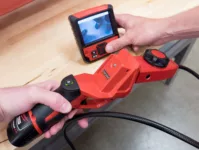When it comes to choosing the best model of inspection camera, unfortunately there is no one best model to suit all applications. The model that you choose will be very much dependent on your need. Inspection cameras are used for so many purposes and it would be best to consider your own need prior to even looking at the models that are available. Inspection cameras are used to view inaccessible spaces which cannot be seen by the human eye, in drains, under floors, in roof spaces, behind walls and even in the human body, there are so many applications. The cameras come with a flexible or rigid tube of varying lengths, attached to a camera at one end and a monitor at the other end. Technology is such now that the camera can be attached to a mobile phone or tablet and is capable of not only displaying the picture of what is behind the structure but it can also photograph and record the images with high resolution allowing the user to have a clear and accurate picture of what is going on. The applications are endless and the time, effort and money that they can save a company is quite considerable. Consider a surgeon working to save someone’s life, the examinations that can take place can provide a quick diagnosis and it takes a lot of the ‘guesswork’ out of the equation for the surgeon.
What about the engineer who is working on large pieces of machinery, maybe on an aircraft or HGV. Without the camera, diagnostics would involve dismantling large pieces of equipment to attempt to get to the route of the problem whereas the camera can be used in very small spaces and between structures to save the time and effort involved in taking the machinery to pieces. The cameras have various features, some of which are listed below and it is up to the purchaser to decide on the features that they would need. Costs vary with some of the very sophisticated machines costing quite a bit to some of the less involved cameras being within easy reach of most homeowners, meaning that they can be used for applications in and around the home too.
You can read more about inspection cameras through other sources. Read the following guide after you’ve been through this full review: Top 10 Best Inspection Camera (Reviews).
So, the features that you may want to consider
- What size does the camera need to be?
- What length of tubing do you require and how strong does it have to be?
- Do you require it to be waterproof?
- How much illumination do you require?
- What size of flash memory would you require?
- Would you need a zoom feature?
- Do you need to be able to rotate the image on the screen?
- Would you require that the camera switches itself off after a period of inactivity?
- Do you require the ability to be able to record your voice to describe what is seen by the camera as the images emerge?
With so many different options, the best model will be the one to suit your application, read the reviews to hear from those who have bought the camera. You do want your camera to be of a good, robust quality, capable of clear and meaningful images.








